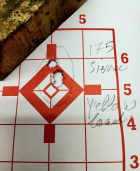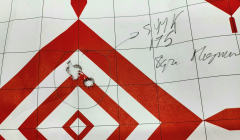Just some thoughts, I went over the Hornady podcast with a fine tooth comb and gave it some thought, now my house smells!


Bare with me it may seem that I'm going the long way around the barn when it fact I am going the long way around the barn. It will eventually get to bench rest shooting.
Much of what the Hornady technicians said has been born out in my many decades of loading and testing for field shooting. For example cold bore 3 shot game rifle grouping and zeroing. I have always shot three shot groups because the barrels never printed good 5 shot groups and I never considered needing more that 3 shots and in practice I rarely needed 2 shots. Like the podcast said test as you would use.
Shooting the same target 3 times at the same point of aim 5 times over an entire day produces a 15 shot group. Doing the same thing 4 times over a period of a month gives you a set of 4 targets with 60 shots.
The single 3 shot groups are never over an inch sometimes under an inch however the composite of 2 groups may be 1 3/4" and the composite of 5 groups of 3 shots each or more may be as much as 2 1/2". What also happens is that by examining the multiple 3 shot groups a natural center of the combined groups appears. By adjusting the zero to the combined natural combined zero of the targets the rifle will always produce a 3 shot group 1" or less in size, but you can increase the likelihood that the 3 shot 1" or less group will be closer to the point of aim by a factor of 5.
Now the very same process has been shown to be true with my 3 heavy barreled custom rifles. It just takes less time as they can shoot 5 shot groups without barrel heating issues. The difference being that the medium game rifles are test grouped at 100 yards shooting 1/2" to 1" groups and the custom rifles are tested at 300 yards shooting from 3/8" to 1 1/4" groups.
The result being that all rifles shoot the 1 or 2 shots needed to the statistically most likely point of aim for all ranges within the rifles accuracy potential.
All this assumes that all rifles have been loaded with loads that already produced a satisfactory accuracy. The medium game rifles accuracy was developed over many days using a 3 shot group and a cooling before the next 3 shot group with the best grouped load used. The custom rifles used 5 shot groups at 200 yards over a period of days with the best grouped load used.
How this applies to the bench rest concept is certainly more of a condrum however a few things stick out. I do field shoot so the previous discussion is not only relevant, it is how I've done it for decades, it just seemed logical. Unlike the previous discussion I have no dog in the bench rest hunt as I don't bench rest shoot.
The first obvious observation is the precision, I don't mean the shooting, I mean the rifle and load construction.
The Hornday technicians mentioned bench rest shooting but not that their loading techniques were tuned to those standards. However I see nothing that preludes their observations from being correct, only that the precision of the bench shooting process may reduce the spread of the errors indicated in the Hornady testing process not the sampling size needed to obtain the data.
Bench rest shooters point to the trophies as proof they do things correctly. As far as statistical data gathering, winning indicates a win on that day and that's it. None of the following concepts precludes that on the day of an event that the winner of that event was the best on the field that day, the trophy proves who was best that day. The following concepts only prove that the bench rest event event was not designed to collect load and ballistic data in a statisticallyuseful way.
The reasons that the win proves only that it was a one off situation are multiple, one reason is that the shooter does not win every time nor most of the time and in fact may not even place in the next event. Other indicators that the win is a one off situation is the multitude of uncontrollable variables between the rifle and point of impact, the small shot count sampling in the data and the fact that some shooters change the load between shots.
For the bench rest shooter to provide the statistical data that they did things correctly they would have to fire the same unchanged load producing a 30 to 60 shot sample providing the evidence.
For a data technician to demand that statistical proof would seem to me that the technician didn't understand the bench rest shooter. It's an art form!
For the bench rest shooter to discount the coincidental alignment of circumstances out of their control that provides the edge that took the day in my opinion is disingenuous.












